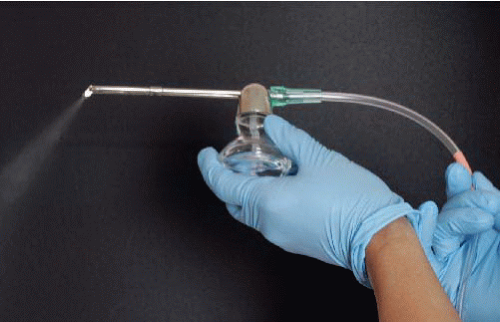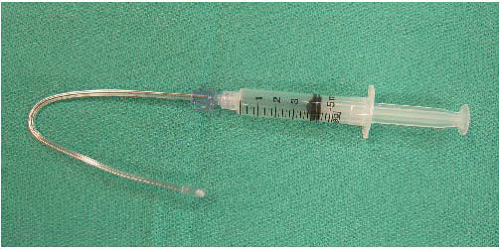Anesthesia and Sedation for Awake Intubation
Alan C. Heffner
Peter M.C. DeBlieux
INTRODUCTION
Humans protect their airway at virtually any cost. In fact, it is generally impossible to even glimpse the glottis with a laryngoscope in a fully awake and aware patient. The “awake” methods of endoscopy referred to in the difficult airway algorithm are rarely performed without pharmacologic assistance. Even in patients who are unaware because of their illness, sensibilities must be attenuated by a combination of local anesthesia and systemic sedation in order to facilitate diagnostic and therapeutic airway endoscopy.
Focusing on emergency airway management, the “awake” intubation is frequently indicated in situations where abnormal airway anatomy or difficult laryngoscopy is suspected. As a general rule, local anesthesia is first optimized in order to limit potential untoward effects of systemic sedation. In uncooperative or decompensating patients, however, sedation may dominate over local anesthesia.
DESCRIPTION
Awake laryngoscopy has two main roles, both of which apply to patients with anticipated difficult intubation: (1) to determine whether intubation is feasible, thus facilitating a decision regarding the use of neuromuscular blockade to complete the procedure, and (2) to intubate, particularly in circumstances when the patient’s airway is deteriorating (i.e., the dynamic airway) as in angioedema, upper airway burns or trauma.
An awake look intended to determine the feasibility of nasal or oral intubation can be accomplished in two ways. A flexible endoscope (e.g., flexible fiberoptic or video bronchoscope or nasopharyngoscope) is inserted through the nostril to evaluate periglottic anatomy in patients with neck disease or acute injury to determine if nasal intubation or orotracheal intubation is feasible. This can be performed quickly with topical nasal anesthesia and minimal, if any, sedation.
The second approach engages a standard or video laryngoscope to perform laryngoscopy, with the intention of confirming glottic visualization. Awake rigid laryngoscopy is more stimulating and requires greater degrees of local anesthesia and sedation than does its flexible endoscopy counterpart. Concentrated local anesthesia of the mouth, oro- and hypopharynx facilitates the procedure and minimizes the dose of systemic sedation required. If the glottis is adequately visualized, the airway manager may either proceed with awake intubation, or may withdraw the laryngoscope and perform rapid sequence intubation (RSI). The approach is dictated by the clinical circumstance.
If the difficult airway is rapidly dynamic and evolving, then it is advisable to intubate the patient during the awake direct or video laryngoscopy, as the airway may deteriorate significantly within minutes or as a result of laryngoscopic manipulation. If there is reasonable concern that the airway might change, intubation should be attempted on the first good opportunity.
If the difficult airway is subacute to chronic and is more a confounder to intubation than the primary reason for airway crisis (e.g., fixed cervical or maxillofacial disease), then the goal is to confirm feasibility of intubation. Glottis visualization is followed by laryngoscope withdrawal and proper RSI, with the knowledge that the airway is very unlikely to deteriorate further between steps. Cases of slowly evolving acute disease (e.g., infection and inhalation burn) are reasonable opportunities to take the same approach. Appropriate supplies and drugs are prepared before the first laryngoscopy to minimize the delay to definitive RSI.
INDICATIONS AND CONTRAINDICATIONS
Awake intubation is indicated when the airway manager is not confident that gas exchange will be assured by any or all of the airway techniques if the patient is rendered apneic (see Chapters 2 and 3). Although the difficult airway assessment defines an airway as potentially difficult if it meets any or all of a number of markers (LEMON), the degree of perceived difficulty and the decision whether to use an RSI technique or an awake approach depend both on the patient and experience and judgment of the clinician. Local anesthesia of the upper airway with or without sedation facilitates upper airway endoscopy even when intubation is not anticipated. Common indications include airway examination for foreign body, supraglottitis, hoarseness, stridor, and blunt or penetrating neck injury.
The only contraindication to the use of this strategy is a patient who mandates an immediate airway. Rapidly deteriorating airway situations require immediate management through another means, as there is insufficient time for patient preparation before intervention (see Chapter 3 discussion of the “forced to act” scenario). Adequate time and patient cooperation (usually with the use of anesthesia and sedation) are the most important limitations to awake endoscopy. In addition, copious airway secretions or blood thwart efforts to effectively anesthetize the airway and may obscure the view of flexible endoscopes.
LOCAL ANESTHESIA FACTORS
Local anesthesia of the airway may be produced topically, by injection, or by combining both techniques. The selection of a local anesthetic agent depends on the properties of the agent and how it is supplied (concentration and preparation—aqueous, gel, or ointment). Potent local anesthesia may enable the airway to be visualized with little to no sedation. As a general rule, local anesthesia should be optimized before sedation is given to the high-risk patients selected for this technique.
Airway secretions are a barrier to topical anesthetics and are capable of diluting applied agents or washing them away from the intended target region. Antisialogogues are effective adjuncts to reduce secretion production and improve topical anesthesia and endoscopy conditions. The antimuscarinic agent glycopyrrolate (Robinul) is the preferred agent. The greatest drawback is time to effective drying which is 10 to 20 minutes following intravenous (IV) administration (glycopyrrolate 0.01 mg per kg; usual adult dose 0.4 to 0.8 mg IV). Given sufficient time, even if only 10 minutes, it is advisable to administer glycopyrrolate to facilitate local anesthesia of the upper airway.
Lidocaine remains a favored drug for airway anesthesia because of its rapid onset (2 to 5 minutes to peak effect), safety, and widespread availability. Concentrations of 2% (20 mg per ml) to 4% (40 mg per ml) are optimal for topical administration. Addition of epinephrine provides no additional advantage.
Anesthetics applied to mucous membranes undergo rapid systemic absorption. The maximum safe dose of topical anesthetic applied to mucous membranes depends on the method and timing of administration. Although traditional dosage guidelines may be excessively conservative when drugs are administered by aerosol or atomizer, we recommend a maximum lidocaine dose of 4 mg per kg. This dose should be calculated before administration. As always, clinical judgment is required, and meticulous attention to detail is necessary when lidocaine is applied to the airway in order to achieve effective anesthesia without producing toxicity.
Aerosolization of aqueous lidocaine is easy and effective. Gas flow directed nebulizers, as are used for inhalational therapy in asthma, are an effective first step to initiate broad (nasal, oral, and hypopharyngeal) local anesthesia during an emergency airway situation. Four milliliters of lidocaine can be administered over 10 minutes while additional agents and equipment are prepared. Augmentation with additional focused topical application is the norm.
Atomizers produce larger droplets than nebulizers, such that medication rains out in the region local to administration. For topical anesthesia of the upper airway, atomizers are more rapid and effective than nebulizers. The DeVilbiss atomizer (Fig. 23-1) and Mucosal Atomization Device (LMA North America, San Diego, CA) (Fig. 23-2) are two examples of commonly use atomizers.
Lidocaine is also available in gel for paste formulas to permit direct local administration. Some combination of these formula applications often is warranted.











